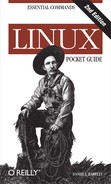Name
cdrecord — stdin stdout - file -- opt --help --version
Synopsis
cdrecord [options]tracks
The cdrecord command burns
a writable CD, DVD, or Blu-ray disc. To burn the contents of a Linux
directory onto a disc readable on Linux, Windows, and Macintosh
systems:[14]
Locate your disc writer’s device by running:
$ cdrecord --scanbus ... 0,0,0 0) * 0,1,0 1) * 0,2,0 2) * 0,3,0 3) 'YAMAHA ' 'CRW6416S ' '1.0d' CD-ROM ...
The device in this case is 0,3,0.
Find out your CD writer’s speed for writing CD-R or CD-RW discs (whichever you’re using). Suppose it is a 6x writer of CD-Rs, so the speed is 6.
Put the files you want to burn into a directory, say, dir. Arrange them exactly as you’d like them on the CD. The directory dir itself will not be copied to CD, just its contents.
Burn the CD:
$ DEVICE="0,3,0" $ SPEED=6 $ mkisofs -R -l dir > mydisk.iso $ cdrecord -v dev=${DEVICE} speed=${SPEED} mydisk.isoor if your system is fast enough, you can do this with a single pipeline:
$ mkisofs -R -l dir | cdrecord -v dev=${DEVICE} speed=${SPEED} -
cdrecord can burn music CDs
as well, but you might want to use a friendlier, graphical program
like k3b instead (see Audio), which is built on top of cdrecord.
[14] Specifically, an ISO9660 CD with Rock Ridge extensions.
mkisofs can create other
formats for cdrecord to burn:
see man mkisofs.
